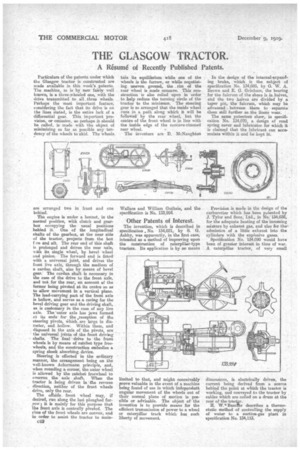THE GLASGOW TRACTOR.
Page 26

If you've noticed an error in this article please click here to report it so we can fix it.
A Résumé of Recently Published Patents.
Particulars of the patents under which the Glasgow tractor is constructed are made available in this week's patents. The machine, as is by now fairly well known, is a three-wheeled one, with the drive transmitted to all three wheels. Perhaps the most important feature, considering the fact that its drive is on the lines stated, is the entire lack of a differential gear. This important provision, or omission, as perhaps it should be called, is made with the object of minimizing so far as possible any tendency of the wheels to skid. The wheels are arranged two in front and one behind.
The engine is under a bonnet, in the normal position, with clutch and gearbox occupying the lanai positions behind it. One of the longitudinal shafts of the gearbox, at the near side of the tractor, projects from the box f Jre and aft. The rear end of this shaft is prolonged and drives the rear axle, eith its single wheel, by bevel wheel and pinion. The forward end is fitted with a universal joint, and drives the front live axle, through the medium of a card= shaft, also by means of bevel gear. The cardan shaft is necessary in the case of the drive to the front axle, and not for the rear, on account of the former being pivoted at its centre so as to allow movement in a vertical plane. The load-carrying part of the front axle is hollow, and serves as a casing for the bevel driving gear and the driving shaft, as is customary in the case of any live axle. The "outeraxle has jaws formed at its ends for. the ,reception of the steering pivots, which, are large in diameter, and hollow. Within them, and disposed in the axis of the pivots, are the nniveesal joints of the front driving shafts. The final drive to the front wheels is by means of ratchet type freewheels, and the construction embodies a spring shock absorbing. device.
Steering is effected in the ordinary manner, the arrangement being on the well-known Ackermann principle, and, when rounding a corner, the outer wheel is allowed by the ratchet freewheel to overrun the axle shaft. When Ile tractor is being driven in the reverse direction, neither of the front wheels drive, only the rear.
The offside, front wheel may, if desired, run along the last ploughed fur. row; it is mainly for this purpose that the front axle is centrally pivoted. The rims of the front wheels are convex, and in order to assist the tractor to main tam n its equilibrium while one of the wheels is the furrow, or while negotiating uneven ground, the . rim of the rear wheel is made concave. This construction is also relied upon in order to help reduce the turning circle of the tractor to the minimum. The steering gear is so arranged that the inside wheel runs in a path along which it will be followed by the rear wheel, but the centre of the front wheel is in line with the inside edge of the concave-rimmed rear wheel. • The inventors are D. McNaughton
Other Patents of Interest.
The invention, which is described in specification No. 134,021, by S. Gr. Ashby, was apparently, in the first case, intended as a method of improving upon the construction of caterpillar-type tractors. Its application is by no means
limited to that, and might conceivably prove valuable in the event of a machine being found of use in which independent angular movement of the wheels out of their normal plane of motion is possible or advisable. The object of the invention is to provide means for the efficient transmission of power to a wheel or caterpillar track which has such liberty of movement.
In the design of the internal-expanding brake, which is the subject of specification No. 134,085, by G. W. A. Brown and E. G. Grinham, the bearing for the fulcrum of the shoes is inhalves, and the two halveS are divided by a taper pin, the fulcrum, which may be advanced between them to separate thorn still further as the liners wear_
The same patentees show, in specification No. 134,070, a design of road spring cover and lubricator for which it is claimed that the lubricant can accumulate within it and be kept in.
Provision is made in the design of the carburetter which has been patented by J. Tylor and Sons, Ltd., in No.'134,038, for the adequate heating of the incoming mixture by exhaust gas, and also for theo admission of a little exhaust into the cylinders with the explosive gases.
Specification No. 134,090 would have been of greater interest in time of war. A caterpillar tractor, of very small dimensions, is electrically driven, the current being derived from a Evince behind the point at which the tractor is working, and conveyed to the tractor by cables which are coiled on a drum at the rear of the. tractpr.
IL W.''Bamllbr describes a thermostatic method of controlling the supply of water to a suction gas plant in specification No. 134,113.


























